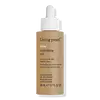What's inside
What's inside
 Key Ingredients
Key Ingredients

 Benefits
Benefits

 Concerns
Concerns

 Ingredients Side-by-side
Ingredients Side-by-side

Carthamus Tinctorius Seed Oil
MaskingCaprylic/Capric Triglyceride
MaskingRicinus Communis Seed Oil
MaskingCocos Nucifera Oil
MaskingCoconut Alkanes
EmollientPassiflora Edulis Seed Oil
EmollientOryza Sativa Bran Oil
EmollientOrbignya Oleifera Seed Oil
EmollientSimmondsia Chinensis Seed Oil
EmollientCoco-Caprylate/Caprate
EmollientTamarindus Indica Fruit Extract
Skin ConditioningAcacia Concinna Fruit Extract
Skin ConditioningEuterpe Oleracea Fruit Oil
Skin ConditioningOenocarpus Bataua Fruit Oil
EmollientSesamum Indicum Seed Oil
EmollientMauritia Flexuosa Fruit Oil
Skin ConditioningOryza Sativa Bran Extract
Skin ConditioningHelianthus Annuus Extract
EmollientPhyllanthus Emblica Extract
Skin ConditioningBacopa Monnieri Leaf Extract
Skin ConditioningEclipta Prostrata Extract
Skin ConditioningWithania Somnifera Root Extract
Skin ConditioningRosmarinus Officinalis Leaf Extract
AntimicrobialParfum
MaskingPhenoxyethanol
PreservativeTocopherol
AntioxidantCarthamus Tinctorius Seed Oil, Caprylic/Capric Triglyceride, Ricinus Communis Seed Oil, Cocos Nucifera Oil, Coconut Alkanes, Passiflora Edulis Seed Oil, Oryza Sativa Bran Oil, Orbignya Oleifera Seed Oil, Simmondsia Chinensis Seed Oil, Coco-Caprylate/Caprate, Tamarindus Indica Fruit Extract, Acacia Concinna Fruit Extract, Euterpe Oleracea Fruit Oil, Oenocarpus Bataua Fruit Oil, Sesamum Indicum Seed Oil, Mauritia Flexuosa Fruit Oil, Oryza Sativa Bran Extract, Helianthus Annuus Extract, Phyllanthus Emblica Extract, Bacopa Monnieri Leaf Extract, Eclipta Prostrata Extract, Withania Somnifera Root Extract, Rosmarinus Officinalis Leaf Extract, Parfum, Phenoxyethanol, Tocopherol
C13-15 Alkane
SolventIsohexadecane
EmollientIsododecane
EmollientIsoamyl Laurate
EmollientEthylene/Propylene/Styrene Copolymer
C9-12 Alkane
SolventHippophae Rhamnoides Fruit Oil
Skin ProtectingHelianthus Annuus Seed Oil
EmollientCoco-Caprylate/Caprate
EmollientBrassica Campestris/Aleurites Fordi Oil Copolymer
Skin ConditioningCitrullus Lanatus Seed Oil
EmollientMoringa Oleifera Seed Oil
EmollientSimmondsia Chinensis Seed Oil
EmollientOrbignya Oleifera Seed Oil
EmollientPhytosteryl/Octyldodecyl Lauroyl Glutamate
Skin ConditioningButylene/Ethylene/Styrene Copolymer
Amaranthus Caudatus Seed Extract
Skin ConditioningDiisostearyl Malate
EmollientParfum
MaskingCitronellol
PerfumingLimonene
PerfumingCitral
PerfumingLinalool
PerfumingPentaerythrityl Tetra-Di-T-Butyl Hydroxyhydrocinnamate
AntioxidantC13-15 Alkane, Isohexadecane, Isododecane, Isoamyl Laurate, Ethylene/Propylene/Styrene Copolymer, C9-12 Alkane, Hippophae Rhamnoides Fruit Oil, Helianthus Annuus Seed Oil, Coco-Caprylate/Caprate, Brassica Campestris/Aleurites Fordi Oil Copolymer, Citrullus Lanatus Seed Oil, Moringa Oleifera Seed Oil, Simmondsia Chinensis Seed Oil, Orbignya Oleifera Seed Oil, Phytosteryl/Octyldodecyl Lauroyl Glutamate, Butylene/Ethylene/Styrene Copolymer, Amaranthus Caudatus Seed Extract, Diisostearyl Malate, Parfum, Citronellol, Limonene, Citral, Linalool, Pentaerythrityl Tetra-Di-T-Butyl Hydroxyhydrocinnamate
 Reviews
Reviews

Ingredients Explained
These ingredients are found in both products.
Ingredients higher up in an ingredient list are typically present in a larger amount.
Coco-Caprylate/Caprate is created from fatty coconut alcohol, caprylic acid, and capric acid.
It is a lightweight emollient. Emollients create a thin barrier on the skin to trap moisture in. This helps keep your skin hydrated and soft.
Once applied, Coco-Caprylate/Caprate is absorbed quickly and leaves a silky feel.
Coco-Caprylate/Caprate may not be fungal acne safe.
Learn more about Coco-Caprylate/CaprateOrbignya Oleifera Seed Oil is from the seed of the Babassu palm plant. This plant is native to Brazil.
Orbignya Oleifera Seed Oil contains many fatty acids with the most being lauric acid.
Like other plant oils, Orbignya Oleifera Seed Oil is hydrating and can help soften skin.
It is also an antioxidant. Antioxidants help fight off damage from free-radical molecules.
One study found this oil might contain anti-inflammatory properties, but more research is needed.
Learn more about Orbignya Oleifera Seed OilParfum is a catch-all term for an ingredient or more that is used to give a scent to products.
Also called "fragrance", this ingredient can be a blend of hundreds of chemicals or plant oils. This means every product with "fragrance" or "parfum" in the ingredients list is a different mixture.
For instance, Habanolide is a proprietary trade name for a specific aroma chemical. When used as a fragrance ingredient in cosmetics, most aroma chemicals fall under the broad labeling category of “FRAGRANCE” or “PARFUM” according to EU and US regulations.
The term 'parfum' or 'fragrance' is not regulated in many countries. In many cases, it is up to the brand to define this term.
For instance, many brands choose to label themselves as "fragrance-free" because they are not using synthetic fragrances. However, their products may still contain ingredients such as essential oils that are considered a fragrance by INCI standards.
One example is Calendula flower extract. Calendula is an essential oil that still imparts a scent or 'fragrance'.
Depending on the blend, the ingredients in the mixture can cause allergies and sensitivities on the skin. Some ingredients that are known EU allergens include linalool and citronellol.
Parfum can also be used to mask or cover an unpleasant scent.
The bottom line is: not all fragrances/parfum/ingredients are created equally. If you are worried about fragrances, we recommend taking a closer look at an ingredient. And of course, we always recommend speaking with a professional.
Learn more about ParfumThis oil comes from the seeds of the desert shrub called Jojoba. It is more commonly known as jojoba oil, a non-comedogenic oil.
Jojoba oil does not contain fragrance and has many fatty-acids, making it a great soothing ingredient.
It also contains Vitamin E, a great moisturizing ingredient. Vitamin E is also an antioxidant and protects your skin against oxidative damage.
This ingredient humectant properties, meaning it helps draw moisture from the air. This helps keep your skin hydrated.
While jojoba has antibacterial properties, it is only able to kill some strains of bacteria.
Studies also show it helps in wound healing. In fact, Indigenous cultures have used jojoba as a moisturizer and to help treat burns for centuries.
Fun fact: Jojoba oil similar to natural human skin sebum, so it has a great effect on dry skin. It is also promising with helping to regulate sebum production.
Due to its fatty acid content, Jojoba oil may not be fungal acne safe. We recommend speaking with a professional if you have any concerns.
Learn more about Simmondsia Chinensis Seed Oil